If you thought that all chicken breeds look more or less the same, then you have not encountered the Silkie chicken breed.
Silkies are a great sight to behold as much as they are fun to interact with. But even with their cute looks, Silkie chickens have a lot more to offer, as you will see in this guide.

Table of Contents
History
Named for its unusually fluffy and silk-textured plumage, it is unknown exactly when and where the Silkie chicken breed was first developed.
That said, many believe this breed may hail from ancient China among other places in Southeast Asia like Java and India.
The earliest Western account of an encounter with this fascinating chicken breed was by Marco Polo in the 13th century when he wrote about a “furry” chicken.
While it is unclear when the breed first came to the West, it was accepted into the Standard of Perfection by the American Poultry Association in 1874.
Similarly, the Silkie chicken was accepted into the British Poultry Standard of Perfection in 1865 and into the Australian Poultry Standard in 1998 for bantams only.
Owing to their unusual appearance, the entry of Silkies to the West was followed by numerous myths about their existence.
Dutch breeders made buyers believe that Silkies were bred from chickens and rabbits.
Sideshows, on the other hand, promoted the idea that the Silkie chicken had true mammalian fur.
Today, the Silkie chicken breed is among the most common general-purpose and ornamental breeds raised.
They make great pets and come in handy at incubating and raising the hatchlings of other domesticated birds like ducks, chickens, and geese.

Appearance
There is no doubt that Silkie chickens are different from any other bird you have ever seen.
Breeders say that their feathers have a satin or silk-like feel, which is where they get their name from.
Aside from their unique feathering, Silkie chickens have broad bodies with full chests and short backs — giving them a well-rounded or plump look.
Like the Polish chicken breed, Silkies have a crested pom pom-like head that is hard to miss.
Roosters, like other birds, have a walnut-shaped comb that has a deep mulberry color, especially in purebred fowls. Depending on the feathering growth, the comb, and the turquoise ear lobes may appear hidden.
What’s more, the chickens have black eyes and a broad-base bill that can be blue or gray.
Though the gray legs of this chicken breed are quite short, they are wide set to guarantee stability, especially since Silkies are plump birds.
Unlike other chicken breeds, Silkies have five toes of which the outer two are feathered. This is yet another fascinating thing about Silkie chickens.
Underneath their fluff, Silkie chickens have a black pigment that extends from their skin to their muscles down to the bones.
The meat, however, is delicious like other poultry meat. The black pigmentation and flavor of the meat have rendered the chickens a unique dish in some cuisines.
It is also used in Chinese medicine due to its anti-aging properties.
The fluffy look of the Silkie chickens results from the lack of barbicels that hold feathers together in other chicken breeds. Essentially, their main feathering is similar to the under-down of regular chicken breeds.
Due to the lack of barbicels in their feathers, Silkie chickens cannot fly.
It also means that the feathering is not waterproof, and the chickens might need to be toweled or blow-dried should they get themselves significantly wet.
Lastly, Silkies can be categorized as bearded and non-bearded. The bearded-type features an additional muff of feathers on the bill area and covers the bird’s ear lobes.
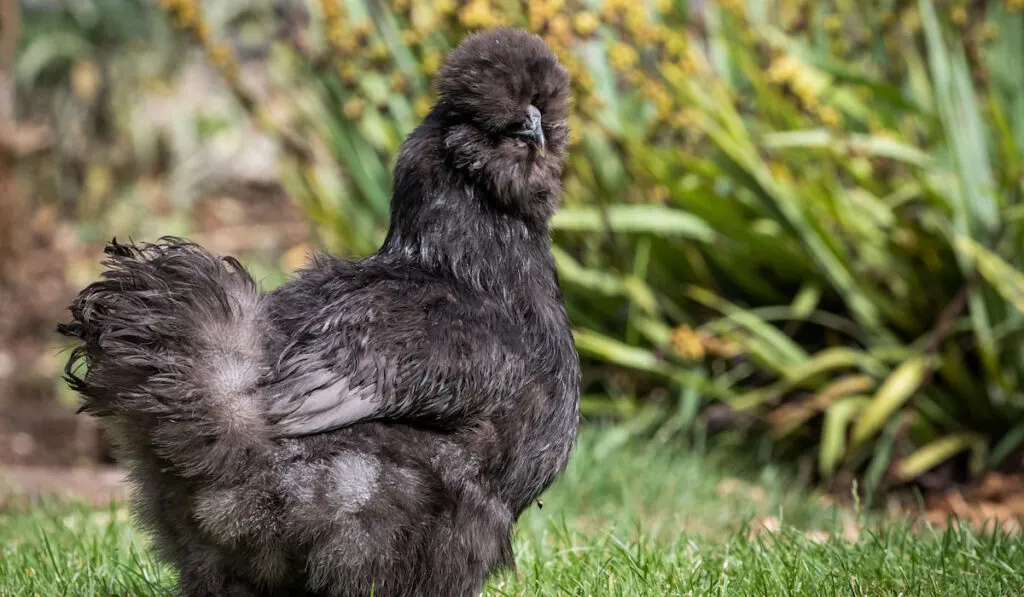
Size and Weight
Silkies in the US are usually slightly smaller than their counterparts in Europe. Their accepted weight is 2 to 3 pounds for roosters and 1 ½ to 2 pounds for hens.
The Silkies also come in bantam size with accepted weight being 36 ounces for roosters and 32 ounces for hens.
Interestingly, all Silkie chickens in Canada and the US are considered bantam regardless of their size.
Other countries in the world recognize both bantam and large fowl types.
On the other hand, large fowl Silkies in the UK weigh close to 4 pounds for roosters and 3 pounds for hens. Bantams should weigh close to 21 ounces for males and 18 ounces for females.
Egg Production
Silkie chickens are considered poor layers and do not make a great option for an egg-producing breed.
Their threshold averages 2 to 3 small eggs each week and they start laying within the age of one year. This makes for 100 to 120 tinted or cream eggs per year.
That said, Silkie hens excel at brooding and make exceptional mothers.
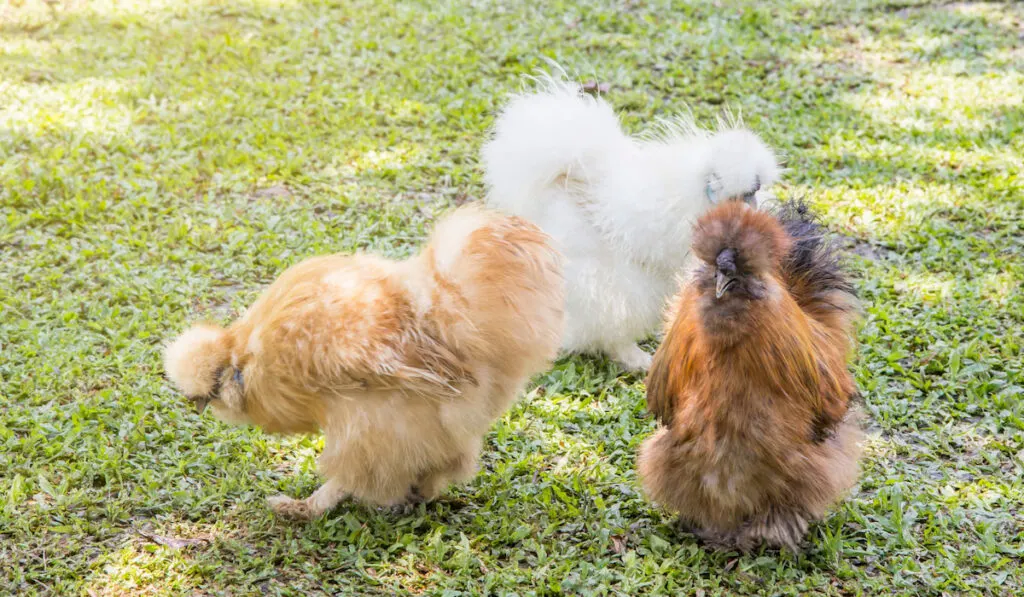
Colors
The Silkie chicken breed is available in a variety of colors. However, the American Poultry Association only recognizes these that include:
- White
- Black
- Blue
- Buff
- Partridge Gray
There are several other colors available, but they are yet to be accepted in the APA. They include:
- Lavender
- Red
- Cuckoo
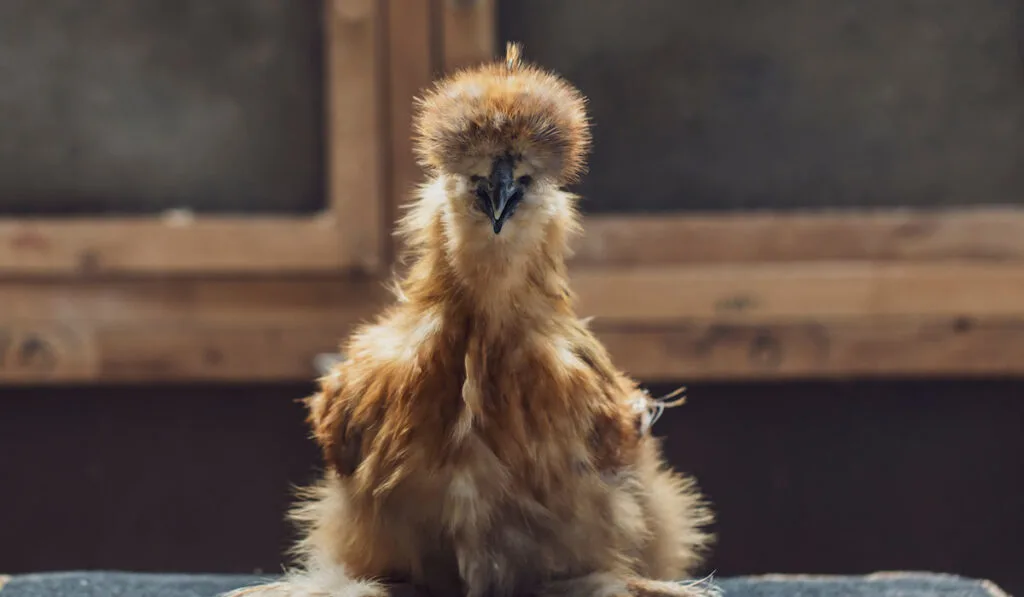
Temperament
Silkies are an extremely docile, calm, and friendly breed. So much so that they easily get bullied by other aggressive chicken breeds.
They will, however, coexist peacefully with other docile and friendly breeds like the Cochin and Polish.
Contrary to what you may expect, the roosters are as mellow with humans as they are with chicks. Roosters have been seen helping chicks learn what is good and safe to eat.
Silkies love interacting with humans and make great pets for children.
They especially love lap time, being blow-dried when wet, and of course, cuddling. All these make perfect sense considering the birds’ cuddly nature.
Lifespan
Judging from their resilient history, it is quite evident that Silkies are a vigorous breed. Except for a few health issues, the birds can live for an average of 7 to 9 years, longer with exceptional care.
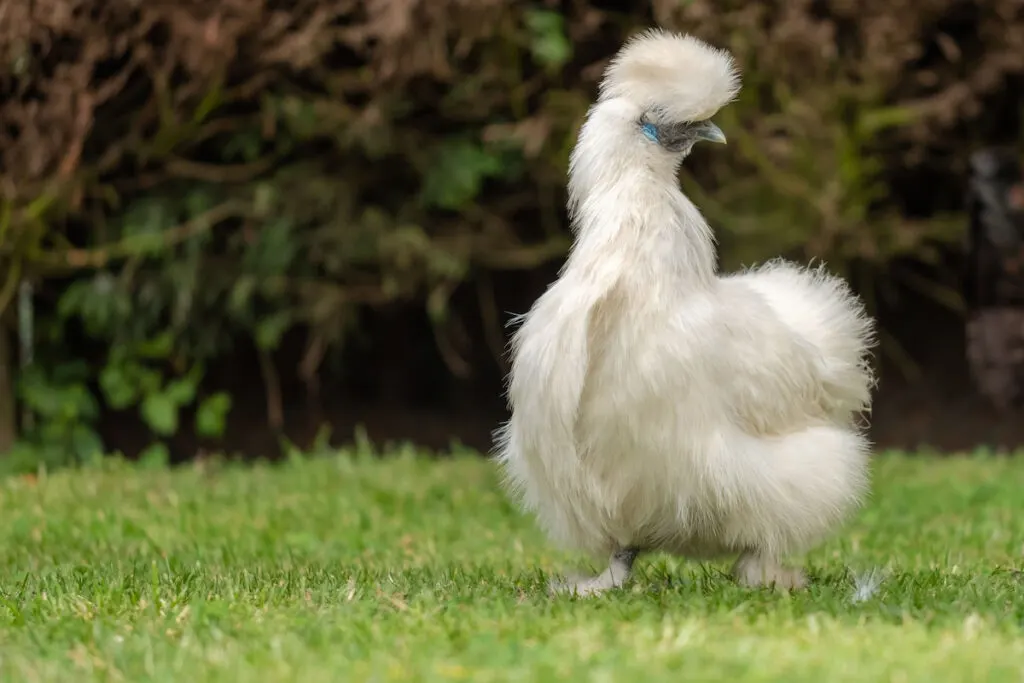
Exhibition
Raised as an ornamental bird, it only makes sense for the Silkies to put on a show to flaunt their beauty.
If anything, Silkies are among the most popular exhibition breeds in the United States.
Even with their genetic makeup on their side, the birds must be washed and dried at the right time to fully fluff them up to meet the competition standards.
All this is worthwhile because poorly prepared birds usually fail the show despite their genetic makeup.
Sexing
Unlike other chicken breeds, Silkies are incredibly challenging to tell apart.
Experienced breeders may take their guess, but it is not until roosters start to crow, which happens at around six months, can one truly tell apart Silkie hens and roosters.
Noise Levels
Silkie chickens are among the quietest breed you will come across. So much so that they even perform their egg song quietly.
This quiet and calm nature is what makes the chickens perfect apartment pets.
Keep in mind that while the hens will rarely fuss, the roosters will still crow, which might still irritate your neighbors. This is true even though Silkie roosters are considered quieter.
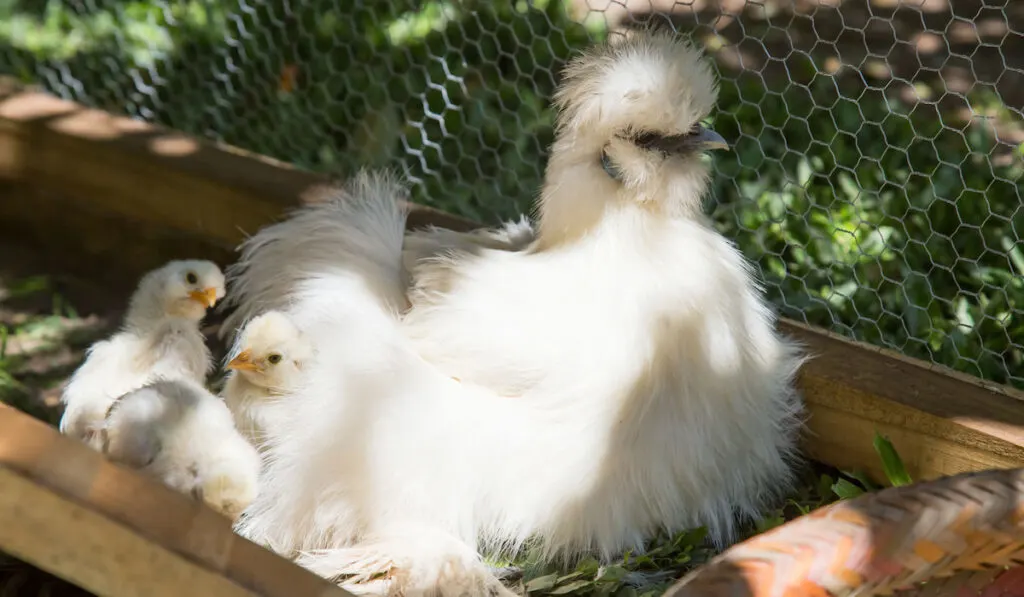
Brooding
Though not the best layers out there, Silkie hens have an extremely strong broody instinct. Over the years, the hens have been shown to successfully brood the eggs of other birds and waterfowl like geese.
Since the broody instinct is quite strong in these birds, keep an eye on them to ensure they feed and hydrate when sitting on eggs. They are also excellent mothers.
As great as they are, Silkie hens have a dense under feathering that can tangle around chicks leading to death.
For this reason, it helps to have a Silkie cross with harder and firmer feathers to reduce the risk.
Common Health Issues
As hardy as they are, Silkies are sadly prone to contracting Marek’s disease. This viral disease causes paralysis, and sometimes tumors eventually leading to death.
Luckily, you can choose to have your Silkie flock vaccinated or you can breed it for natural immunity.
Another thing you want to watch out for with Silkies is lice and mites. Silkies are prone to pest infestation due to their fluffy nature and the fact that their feathering is not waterproof.
Luckily, you can easily treat these with the right pesticides. You can also schedule regular treatments which will also serve as a preventative measure.
Lastly, regular trimming is a great way to keep your Silkie flock neat and disease-free.
For instance, trim the feathers around the rear fluff for breeding and hygiene purposes. And around the eyes for better visibility.
Nutrition
Though Silkies are usually okay in confinement, they make excellent foragers when allowed to free range. As a result, they can supplement their diet with bugs, insects, and weeds.
Remember to also supplement their feed with fresh greens to keep them happy, active, and of course, healthy.
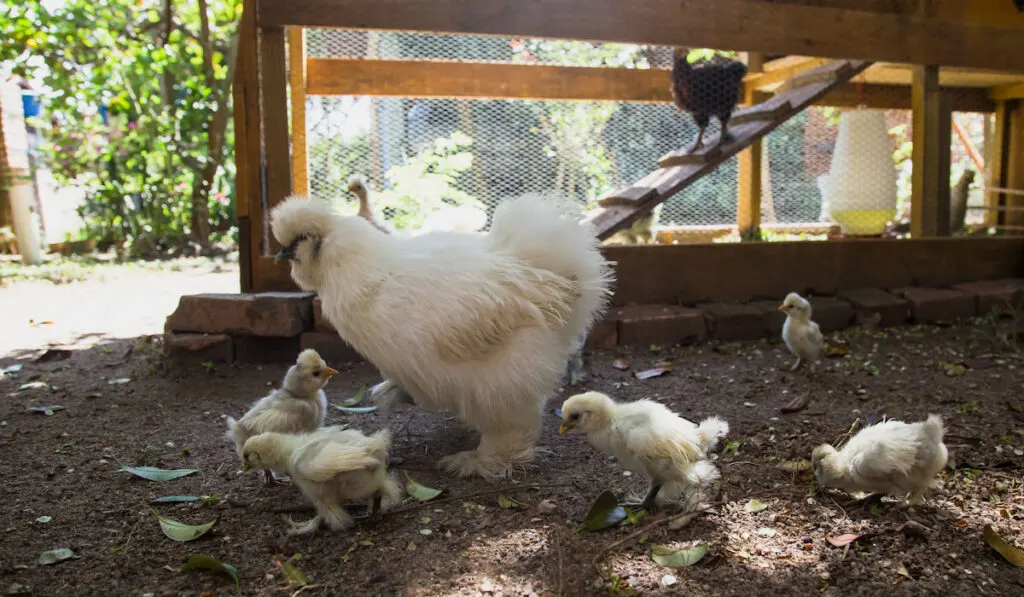
Housing
Consider allocating each Silkie in your flock at least 4 square feet when designing your coop.
This will ensure that each bird has enough room to move around, feed, and sleep.
Since the birds love to pile up on the floor to sleep, having a raised platform will help keep insects and rodents at bay at night.
As far as nesting goes, you can choose to have them on the ground. Or you can have them on a raised platform with a ramp to make access easy for these flightless birds.
As for roaming, it will help to have an outdoor area like a run that is shielded from predators. In this case, overhead protection will also come in handy to keep owls and hawks away.
For an outdoor run, consider allocating at least 8 square feet per bird in the run.
Final Thoughts
While Silkies are not the best egg-producing chicken breed, there is a lot to love about this chicken breed.
From excellent sitters, compassionate mothers, and great pets for your kids, you can never go wrong with Silkie chickens.
Luckily, the breed is quite hardy, requires minimal maintenance, and will make a suitable addition to your flock.
Resources
- https://nre.tas.gov.au/biosecurity-tasmania/animal-biosecurity/animal-health/poultry-and-pigeons/mareks-disease
- https://poultrykeeper.com/chicken-breeds/silkie-chickens/
- https://www.agrifarming.in/silkie-chicken-breed-profile-characteristics
- https://www.raising-happy-chickens.com/silkie-chickens.html#characteristics
- https://en.wikipedia.org/wiki/Sideshow
- https://www.thehappychickencoop.com/silkie-chicken/
- https://the-chicken-chick.com/poultry-lice-and-mites-identification/
- https://www.chickensandmore.com/silkie-chicken/
